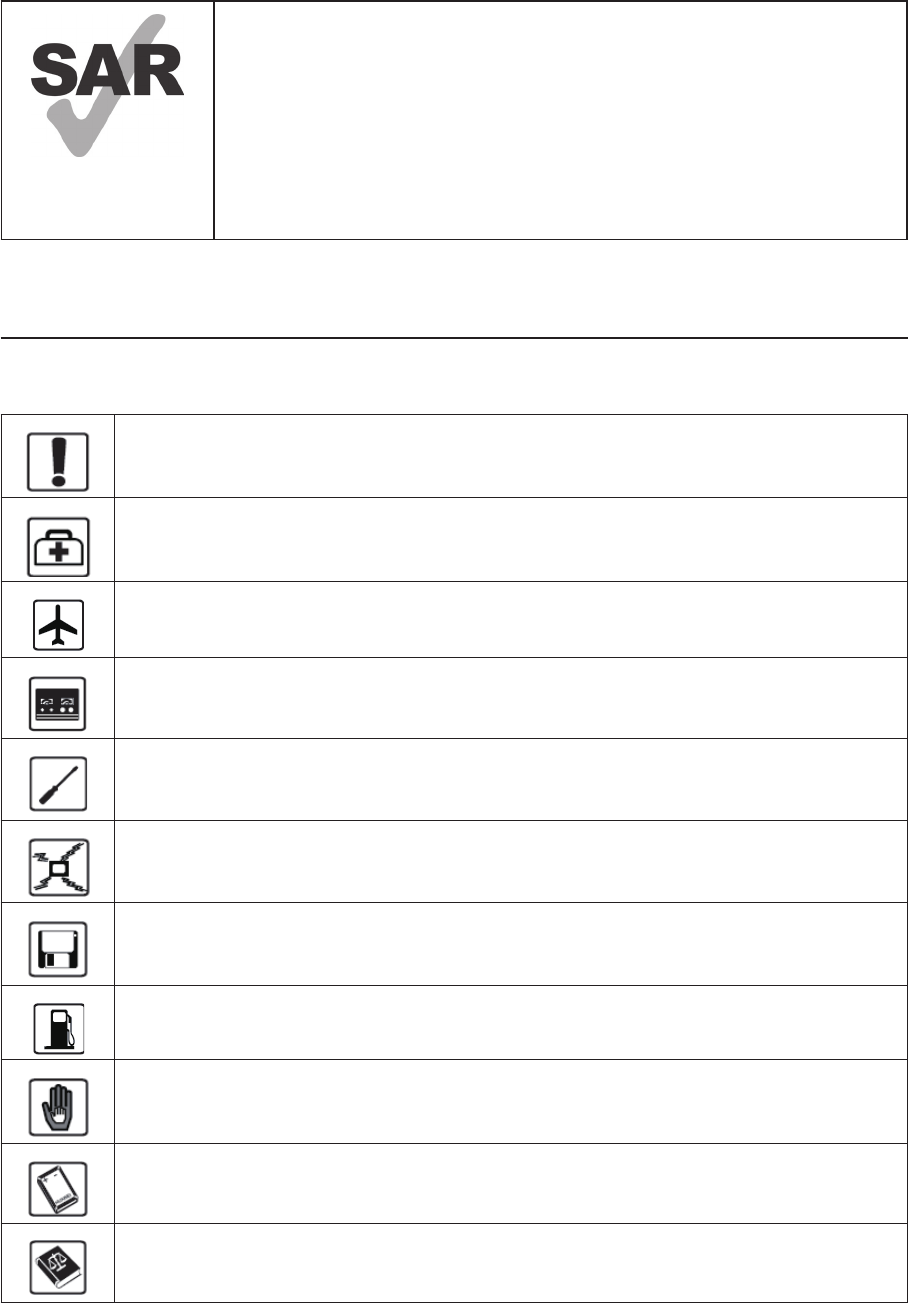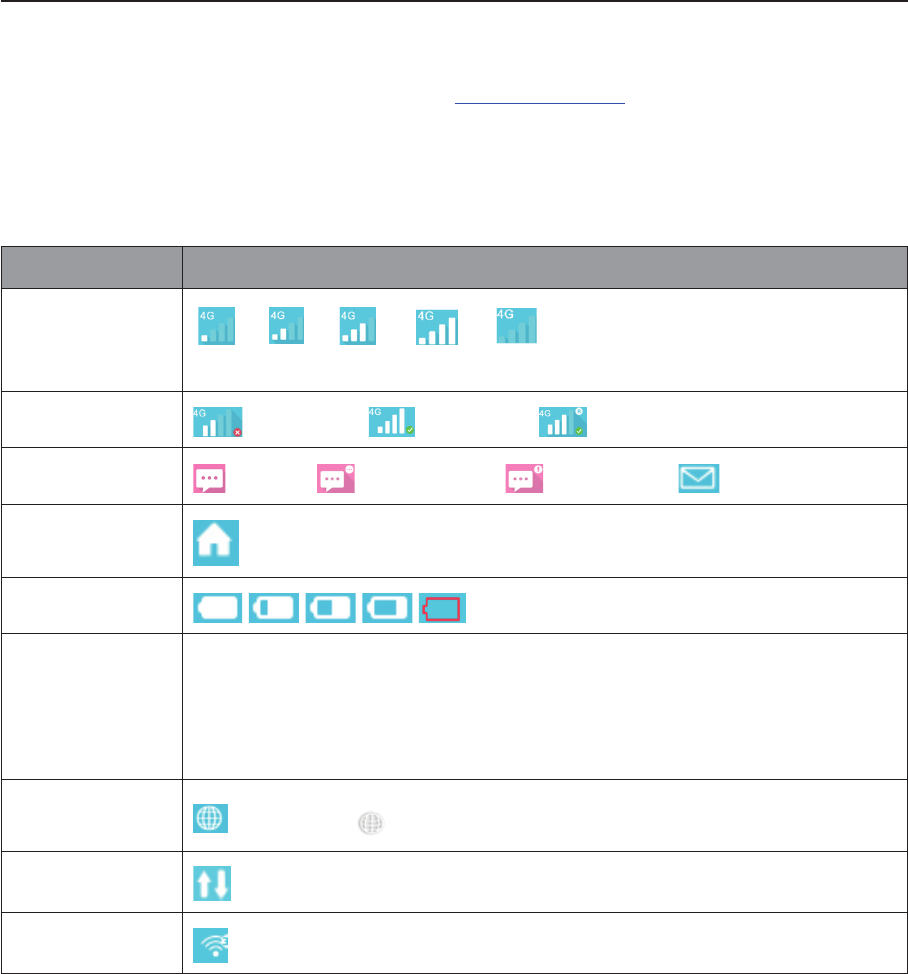TCL Communication B022 LTE USB Modem/4G AP User Manual
TCL Communication Ltd. LTE USB Modem/4G AP
User manual
User Manual

2
www.sar-tick.com
This product meets applicable national SAR limits of 1.6W/kg.
The specic maximum SAR values can be found in the section of this
user guide.
When carrying the product or using it while worn on your body, either
use an approved accessory such as a holster or otherwise maintain
a distance of 10 mm from the body to ensure compliance with RF
exposure requirements. Note that the product may be transmitting
even if you are not Surng Internet.
Safety Precautions
Read the safety precautions carefully to ensure the correct and safe use of your wireless
device.
Do not switch on your device when the device use is prohibited or when the
device use may cause interference or danger.
Follow the rules or regulations in hospitals and health care facilities. Switch off your device
near medical apparatus.
Switch off your device in an aircraft. The device may cause interference to control signals of
the aircraft.
Switch off your device near high-precision electronic devices. The device may affect the
performance of these devices.
Do not attempt to disassemble your device or its accessories. Only qualied personnel are
allowed to service or repair the device.
Do not place your device or its accessories in containers with strong electromagnetic eld.
Do not place magnetic storage media near your device. Radiation from the device may erase
the information stored on them.
Do not put your device in a high-temperature place or use it in a place with ammable gas
such as a gas station.
Keep your device and its accessories away from children. Do not allow children to use your
device without guidance.
Use approved batteries and chargers only to avoid explosion.
Observe the laws or regulations on device use. Respect others’ privacy and legal rights
when using your device.
It is recommended that the equipment only be used in the environment where temperature
is between 0°C and 45°C and humidity is between 10% to 90%. Keep the equipment in the

3
environment where temperature is between -10°C and 70°C or humidity is between 10% to
90%.
CHARGERS
Mains powered chargers will operate within the temperature range of: 0°C to 40°C.
The chargers designed for your device meet with the standard for safety of information
technology equipment and ofce equipment use.
They are also compliant to the ecodesign directive 2009/125/EC. Due to different applicable
electrical specications, a charger you purchased in one jurisdiction may not work in another
jurisdiction. They should be used for this purpose only.
1. Web UI conguration
1.1 login the conguration page
Open the browser, and then input the address http://192.168.1.1.
The default login password is admin.
1.2 Icon description
The icon description as bellow:
Category Icon Display
Signal Strength
From no signal to excellent
Network Status Disconnect, Connected, Roaming
SMS Normal, New message, SMS box full, View Message
Home click to go back to Home page
Battery Battery Level
Network Type
2G: EDGE, GPRS;
3G: HSPA, HSUPA, UMTS;
3G+: HSPA+, DC-HSPA+;
4G: LTE
Connection
Status Connected, Disconnected
Usage Usage Data
Wi-Fi status Wi active with connected Devices
Tab 2.1

4
2. Connection
Click “Connection” area to open connection menu, including connection info, upload/
download usage (for a connected duration), network technology, battery status, number of
device connected are included.
2.1 Connection Information
¾Turn on/off Key: connect/disconnect from internet;
¾Network information: display Operator name, if network is roaming, the icon “R” appeared
on right of operator name, otherwise, hidden “R” icon;
2.2 Usage Information
A current usage time and data is displayed
¾ Total time duration for current connection in HH;MM (e.g: 12Hrs 02 Mins);
¾ Total data for current connection in MB or GB;
2.3 Signal & Technology Info
¾ Signal icon: Shows the signal strength, Icon is grey if no service;
¾ Network technology: 2G, 3G, 3G+, 4G in different network; Icon is empty in disconnected
and no service status;
2.4 Battery information
¾ Lower power
¾ Different battery level
2.5 Connected devices information
This component shows the connected devices to this device.
¾Device list edit: click “numbers” to view detail connected devices. Click to edit the
device name, and to save the changes, click any other area to give up the changes;
¾Block list edit: click “Block” or “unblock” to manage device list, but USB Device cannot be
blocked
3. Usage
Click “Usage” area to open usage status menu, display usage info in home and roaming status,
including upload/download data transfers.
3.1 Usage information
¾Home: local download + upload usage, current Volume/total Volume; Clear all data when
start a new period cycle;
¾Roaming: current Roaming Data and Total Roaming Data
¾Duration: Duration time for each connection; Total time duration for a specied connection
period;

5
3.2 Clear History
¾Click top right option menu, selected “Clear History” in draw menu
¾When billing day, automatically clear all usage database
¾If usage or time excessed limitation, when set a new usage plan or Time limitation plan, clear
previous database automatically.
¾If usage or time haven’t excessed limitation, When set a new usage plan or time limitation
plan, database will not be cleared
3.3 Usage setting
Click top right option menu, selected “Usage setting” to set Usage data.
4. Message
Click “SMS” area to enter Message interface, the following items are included:
¾+New message: create new SMS;
¾Draft: save the SMS not sent;
¾ : delete SMS
¾ : send SMS fail
¾ : Option Menu
zSMS setting
zDelete all messages
Read/Reply/Forward SMS
Double click a message to read the entire message; same time a SMS box is displayed for Reply/
Forward
5. Settings
Click “Settings” areas to enter Setting, the following items are included:
¾Wi-Fi Settings: set the parameters related to Wi-Fi;
z802.11 Mode: selected the mode used, such as 802.11 b/802.11 g/802.11 n;
zSSID: This is the name of Wi-Fi network, which was used to identify your Wi-Fi network.
The length of the SSID should be 1-32 characters including “_”.
zSSID Broadcast: The default setting is “Enable”.
zWi-Fi Channel: Different domain has different channels (Channel 1~11 in FCC (US)/IC
(Canada); Channel 1~13 in ETSI (Europe); Channel 1~13 in MKK (Japan))
zMax Number of Users: Set the maximum number of Wi-Fi users. The default and maximum
value is “15”.
zSecurity: set the cipher for Wi-Fi; Select an encryption mode in the list and set your
password. If you select “Disable”, any Wi-Fi enabled device can connect to the device
without the password.
zWEP: Lower security. Works with older Wi-Fi devices. Recommended only if your devices
don’t support WPA or WPA2.

6
zWPA: A strong security standard, supported by most Wi-Fi devices.8 to 63 ASCII
characters needed.
zWPA2: A stronger, newer security standard. Limited to newer Wi-Fi devices. 8 to 63
ASCII characters needed.
¾Login Settings: dene your login password
zLogin password characters: 4-16, if exceeds 16 characters, not allow to proceed;
zIf an invalid character is input, error message is displayed under user name, data not
saved:
zPassword can contain letters, numbers, and symbols (ASCII characters 4-16), but not the
following: ” ; \ & % + ‘ < > ?
¾Prole management: Edit your prole
¾PIN Code Settings: PIN operation: include three behaviors Enable/Disable/Modify
Note:
1. When you entered wrong PIN 3 times, PUK is needed, you can get this key from the operator.
2. PIN code:4-8 digits.
¾Connection mode: Automatic or Manual at draw down list;
¾Network mode: Auto, 2G only, 3G only, 4G only modes in draw down list;
¾Advanced Settings
zDHCP
Router IP Address: The router’s IP address on the LAN. The default setting is
“192.168.1.1”.
Subnet Mask: The router’s internal LAN subnet mask. The default setting is
“255.255.255.0”.
Host Name: Name of web server.
DHCP Server: DHCP Server will automatically assign IP addresses to devices on the
network. The default setting is “Enable”.
DHCP IP Pool: Set a range of IP addresses available to access.
DHCP Lease Time: Amount of time that a Wi-Fi enabled device can use its assigned IP
address before it is required to renew the lease.
zMAC Filter: MAC ltering is used to control specic MAC addresses to access, include
Disable, Allow, and Deny.
Note: The maximum allowed MAC list is 15
¾About: Display your device basic information
zReboot: Restart the device
zReset: Reset the device to the original factory settings
6. More
¾WPS
zWPS mode: PBC (default) Or WPS PIN, If choose PBC mode, PBC button and guide
reminder display;
zIf choose WPS PIN, WPS PIN put in and guide reminder display. put in WPS pin then click
Save to nish setting

7
¾Online update
Device Auto check SW version, if detect a new SW version, online update reminder icon
display on home page and also under more function sync display.
7. Help
Click Help to open the User Manual.
8. Battery Charging
¾Wall Charger charging
When the device is powered off, charging will take a maximum of 3 hours
¾USB Cable charging
Charging the device by connecting it to a PC with the USB cable.
When the device is powered off, charging will take a maximum of 4 hours.
9. Warranty
• The device is warranted against any deviation from technical specications for a period of
twelve (12) months from the date specied on your original invoice1.
• Under the terms of this warranty, you must immediately inform your vendor in case of a
conformity defect on this device, and present a proof of purchase.
• The vendor or repair center will decide whether to replace or repair this device, as
appropriate.
• Repaired or replaced this device are warranted ONE (1) month unless there are statutory
provisions to the contrary.
• This warranty shall not apply to damage or defects to this device due to:
1) Not following the instructions for use or installation,
2) Not being compliant with technical and safety standards applicable in the geographical
area where this device is used,
3) Improper maintenance of sources of energy, and of the overall electric installation,
4) Accidents or consequences of theft of the vehicle in which this device is transported,
acts of vandalism, lightning, re, humidity, inltration of liquids, inclement weather,
5) Connecting to or integrating into this device any equipment not supplied or not
recommended by the manufacturer,
6) Any servicing, modication or repair performed by individuals not authorised by the
manufacturer, the vendor or the approved maintenance centre,
7) Use of this device for a purpose other than that for which it was designed,
8) Malfunctions caused by external causes (e.g., radio interference from other equipment,
power voltage uctuations),
9) Faulty connections resulting from unsatisfactory radio transmission or caused by the
absence of radio relay coverage.
1 The mandatory warranty period may vary if overriding statutory provisions are applicable in your jurisdiction.

8
• Warranty is also excluded for this device on which markings or serial numbers have been
removed or altered.
• This device is also warranted against hidden defects (defects inherent in the design,
manufacture, etc.).
• There are no other express warranties than this printed limited warranty, expressed or
implied, of any nature whatsoever.
• In no event shall the manufacturer be liable for incidental or consequential damages of any
nature whatsoever, including but not limited to trading loss, commercial loss, to the full
extent those damages can be disclaimed by law. Some countries/states do not allow the
exclusion or limitation of incidental or consequential damages, or limitation of the duration
of implied warranties, so the preceding limitations or exclusions may not apply to you.
10. Q&A
1. Q: Which browser does the device support?
A: It supports Firefox, Safari 4.0.2----5. 2, IE 7.0----10.0, Opera; Chrome;
2. Q: Which OS does the device support?
A: It supports windows Xp/Vista/7/8; Mac OS X10.5----10.10;
3. Q: How to connect to the device?
A: Open your wireless network connection list and select the relative SSID.
Windows: Right-click Wireless network connection on the task bar, and select
View Available Networks.
Mac: Pull down list from AirPort icon. Select the SSID from the dropdown menu.
iOS: Settings->Wi-Fi. Choose the SSID from the available Networks.
Android: Settings->Wireless controls->Wi-Fi settings. Choose SSID from the
available Networks.
4. Q: How to do if I see the SSID but failed to connect?
A: 1. Check the password you entered is the right one;
2. Check if WPS security enabled on your PC? If so, check the device to see if it is
expecting a WPS action from your PC.
5. Q: How to do if No service ?
A: the possible reason are listed as bellow:
1. Unstable local signal.
2. Hardware problem.
You may:
1. If you are inside a building or near a structure that may be blocking the signal,
change the position or location of the device. For example, try moving the device
close to a window.
2. Check the hardware or use another device and retry.
6. Q: How to do if I forgot Wi-Fi Key?
A: You can reset the device to factory defaults by press Power key and WPS key
together.
7. Q: Why the SSID does not appear in the wireless network list?
A: you can check the device as the suggestion bellow:
9
zCheck the device Status Display for error messages or information.
zRefresh your network list on your computer.
Windows: Click Refresh Network List on the left side of the Wireless Network
Connection screen.
If that does not work you can try the following:
1. Open Network Connections.
2. Right-click Wireless Network Connection and select Properties.
3. Click the Wireless Networks tab.
4. Delete any unused wireless connections from the Preferred Networks list and
click OK.
5. Restart your computer.
Mac: Try rebooting your computer
8. Q: How to do if “PIN lock” or “PUK lock”?
A: The SIM card is locked. Login Web page and Enter your PIN code or PUK code you
got from the operator.
Note: if you entered wrong PIN 3 times, then PUK is needed, and if the wrong PUK
entered 10 times, the SIM card will be locked forever.
9. Q: How to connect/disconnect to the 4G/3G network?
A: Login the web browser, go to Connection click “Connect/Disconnect” button
10. Q: How to set a new PIN for my SIM card?
A: Login web browser, Go to Settings->PIN Code Management
11. Q: Where can I nd information about Internet connectivity and Wi-Fi setup?
A: Login web browser, Go to Connection
12. Q: How to check the volume and time i used before?
A: Login web browser, Go to Usage
13. Q: How to search the network manually?
A: Login web browser, Go to Settings->Network mode, choose manual for network
selection;
14. Q: How to check the model number and rmware versions of my device?
A: Login web browser, go to Settings->About
15. Q: Can I backup and restore my conguration settings?
A: Login web browser, go to Settings->About
16. Q: How to set the device dials to connect internet automatically when turn on the
device?
A: login web browser, and go to Settings->Network mode->AUTO
17. Q: How to change the SSID?
A: login web browser, and go to Settings->Wi-Fi settings
18. Q: How to change the login password?
A: login web browser, and go to Settings->Login settings
19. Q: How to change the Wi-Fi Key?
A: login web UI, and go to Settings->Wi-Fi settings

10
11. Warning and Precautions
Electronic Device
Turn off your device near high-precision electronic devices. The wireless device may affect the
performance of these devices. Such devices include hearing aids, pacemakers, re alarm system,
automatic gates, and other automatic devices can be affected. If you are using an electronic
medical device, consult the device manufacturer to conrm whether the radio wave affects the
operation of this device.
Hospital
Pay attention to the following points in hospitals or health care facilities:
¾Do not take your wireless device into the operating room, intensive care unit, or coronary
care unit.
¾Do not use your wireless device at places for medical treatment where wireless device use
is prohibited.
Storage Environment
¾Do not place magnetic storage media such as magnetic cards and oppy disks near the
wireless device. Radiation from the wireless device may erase the information stored on
them.
¾Do not put your wireless device and other accessories in containers with strong magnetic
eld, such as an induction cooker and a microwave oven. Otherwise, circuit failure, re, or
explosion may occur.
¾Do not leave your wireless device in a very hot or cold place. Otherwise, malfunction of the
products, re, or explosion may occur.
¾Do not subject your wireless device to serious collision or shock. Otherwise, wireless
device malfunction, overheat, re, or explosion may occur.
Children Safety
¾Put your wireless device in places beyond the reach of children. Do not allow children to
use the wireless device without guidance.
¾Do not allow children to put the device in mouth.
¾Do not allow children to touch the small ttings. Otherwise, suffocation or gullet jam can
be caused if children swallow the small ttings.
Operating Environment
¾The wireless device is not water-resistant. Keep it dry. Protect the wireless device from
water or vapor. Do not touch the wireless device with a wet hand. Otherwise, short-circuit
and malfunction of the product or electric shock may occur.
¾Do not use the wireless device in dusty, damp and dirty places or places with magnetic eld.
Otherwise, malfunction of the circuit may occur.
¾On a thunder stormy day, do not use your wireless device outdoors.
¾The wireless device may interfere with nearby TV sets, radio and PCs.
¾In accordance with international standards for radio frequency and radiation, use wireless
device accessories approved by the manufacturer only.
Trafc Safety
When driving, do not use the device.

11
¾When switched on, this device emits electromagnetic waves that can interfere with the
vehicle’s electronic systems such as ABS anti-lock brakes or airbags. To ensure that there is
no problem, do not place this device on top of the dashboard or within an airbag deployment
area.
¾Check with your car dealer or the car manufacturer to make sure that the dashboard is
adequately shielded from this device RF energy.
Conditions of Use
¾Switch this device off before boarding an aircraft.
¾Switch this device off when you are in health care facilities, except in designated areas. As
with many other types of equipment now in regular use, this device can interfere with other
electrical or electronic devices, or equipment-using radio frequencies.
¾Switch this device off when you are near gas or ammable liquids. Strictly obey all signs
and instructions posted in a fuel depot, petrol station, chemical plant, or in any potentially
explosive atmosphere.
¾When this device is switched on, it should be kept at least 15 cm from any medical device
such as a pacemaker, a hearing aid or insulin pump, etc.
¾Do not let children use this device without supervision.
¾When replacing the cover, please note that this device may contain substances that could
create an allergic reaction.
¾Always handle this device with care and keep it in a clean and dust-free place.
¾Do not open, dismantle or attempt to repair this device yourself.
¾Do not drop, throw or bend this device.
¾Do not paint it.
This symbol on device means that these products must be taken to collection points
at the end of their life:
- Municipal waste disposal centres with specic bins for these items of equipment.
- Collection bins at points of sale.
They will then be recycled, preventing substances being disposed of in the environment, so that
their components can be reused.
In European Union countries:
These collection points are accessible free of charge.
All products with this sign must be brought to these collection points.
In non European Union jurisdictions:
Items of equipment with this symbol are not to be thrown into ordinary bins if your jurisdiction
or your region has suitable recycling and collection facilities; instead they are to be taken to
collection points for them to be recycled.
Radio Waves Federal Communications Commission Notice
(United States)
The SAR limit set by public authorities such as the Federal Communications Commission
of the US Government (FCC), or by Industry Canada, is 1.6 W/kg averaged over 1 gram of
body tissue. The highest tested SAR value for this device compliance against the standard is
0.56 W/kg.
12
Although the SAR is determined at the highest certied power level, the actual SAR Level of
the modem while operating can be well below the maximum value. This is because the modem
is designed to operate at multiple power levels so as to use only the power required to reach
the network. In general, the closer you are to a wireless base station antenna, the lower the
power output of the modem.
While there may be differences between SAR levels of various modems and at various
positions, they all meet the government requirement for RF exposure. The modem meets FCC
RF exposure guidelines provided that it is used with this device at least 10mm from the body.
The World Health Organization (WHO) considers that present scientic information does not
indicate the need for any special precautions for use of modem. If individuals are concerned,
they might choose to limit their own or their children’s RF exposure by limiting the length
of use to keep data card away from the head and body. (fact sheet n°193) Additional WHO
information about electromagnetic elds and public health are available on the following
website: http://www.who.int/peh-emf.
This device has been tested and found to comply with the limits for a Class B digital , pursuant
to Part 15 of the FCC Rules. These limits are designed to provide reasonable protection
against harmful interference in a residential installation. This equipment generates, uses and
can radiated radio frequency energy and, if not installed and used in accordance with the
instructions, may cause harmful interference to radio communications. However, there is no
guarantee that interference will not occur in a particular installation If this equipment does
cause harmful interference to radio or television reception, which can be determined by turning
the equipment off and on, the user is encouraged to try to correct the interference by one or
more of the following measures:
- Reorient or relocate the receiving antenna.
- Increase the separation between the equipment and receiver.
- Connect the equipment into an outlet on a circuit different from that to which the receiver
is connected.
- Consult the dealer or an experienced radio/TV technician for help.
Changes or modications not expressly approved by the party responsible for compliance
could void the user’s authority to operate the equipment.
FCC RF Exposure Information (SAR):
This device is designed and manufactured not to exceed the emission limits for exposure to
radio frequency (RF) energy set by the Federal Communications Commission of the United
States.
During SAR testing, this is set to transmit at its highest certied power level in all tested
frequency bands, and placed in positions that simulate RF exposure in usage near the body
with the separation of 10 mm. Although the SAR is determined at the highest certied power
level, the actual SAR level of the device while operating can be well below the maximum value.
This is because the device is designed to operate at multiple power levels so as to use only the
power required to reach the network. In general, the closer you are to a wireless base station
antenna, the lower the power output.
The exposure standard for wireless s employs a unit of measurement known as the Specic
Absorption Rate, or SAR. The SAR limit set by the FCC is 1.6W/kg.
Tests for SAR are conducted using standard operating positions accepted by the FCC with the
device transmitting at its highest certied power level in all tested frequency bands.

13
The FCC has granted an Equipment Authorization for this model device with all reported SAR
levels evaluated as in compliance with the FCC RF exposure guidelines.
For more information you can go to www.alcatelonetouch.com;
Additional information about electromagnetic elds and public health are available on the
following site: http://www.who.int/peh-emf
This device is equipped with a built-in antenna. For optimal operation, you should avoid touching
it or degrading it.
Licenses
The Wi-Fi Logo is a certication mark of the Wi-Fi Alliance.
This device complies with part 15 of the FCC Rules. Operation is subject to the following two
conditions: (1) This device may not cause harmful interference, and (2) this device must accept
any interference received, including interference that may cause undesired operation.
Alcatel is a trademark of Alcatel-Lucent used under license by TCL Communication Ltd.
All rights reserved © 2014-2016 TCL Communication Ltd.
Address: Room 1910-12A, Tower 3, China HK City, 33 Canton Road, Tsimshatsui, Kowloon,
Hong Kong